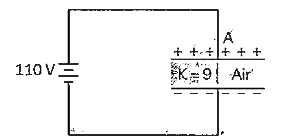A parallel palte capacitor is filled by a dielectric whose relative permittively varies with the applied voltage (U) as ε=αU where alpha =2V−1. A similar capacitor with no dielectric is charged to U0=78V. It is then is connected to the uncharged capacitor with the dielectric. Find the final voltage on the capacitors.
Assuming the requried final voltage be U. if C is the capacitance of the capacitor without the dielectric then the cahrge on the capacitor is given by Q1=CU ltBrgt Since, the capacitor with the dielectric has a capacitance εC. Hence, the charge o the capacitor is given by
Q2=εCU=(αU)CU=αCU
the initial charge on the capacitor is given by
Q0=CU0
From the conservation of charges, Q0=Q1+Q2
Or CU0=CU+αCU2
⇒αU2+U−U0=0
∴U=−1±√1+4αU02α
On solving for U0=78Vanda=2/V, we get
U=6V.
Topper's Solved these Questions
Similar Questions
parallel plate capacitor is filled by a dielectric whose dielectric constant varies with the applies voltage (V) as K = 2V. A similar capacitor with no dielectric is charged to V0=78 volt.It is then connected to the uncharged capacitor with the dielectric.Find the final voltage on the capacitors
View SolutionA parallel plate capacitor is filled by a di-electric whose relative permittively varies with the applied voltage according to the law =αV, where α=1 per volt. The same (but contiaining no di-electirc) capacitor charged to a voltage V=156 volt is connected in parallel to the first ''non-linear'' uncharged capacitor. Determine the final voltage Vf across the capacitors.
View Solution
Knowledge Check
- Question 1 - Select One or More
A parallel plate capacitor A is filled with a dielectric whose dielectric constant varies with applied voltage as K = V. An identical capacitor B of capacitance C0 with air as dielectric is connected to voltage source V0=30V and then connected to the first capacitor after disconnecting the voltage source. The charge and voltage on capacitor.
AAare25C0and25VBAare25C0and5VCBare5C0and5VDBare5C0and25V - Question 2 - Select One or More
A parallel plate capacitor is first connected to a constant voltage source. It is then disconnected and ·then immersed in a liqnid dielectric, then:
AThe capacitance increasesBThe liquid level between the plates increasesCThe liquid level will remain same as that outside the platesDThe potential difference between the plates will decrease - Question 3 - Select One
The capacity of a parallel plate capacitor with no dielectric substance but with a separation is reduced to half and it is filled with a dielectirc substance of value 2.8. The final capacity of the capacitor is
A11.2μFB15.6μFC19.2μFD22.4μF
A parallel capacitor with no dielectric is charged to V0=52V. It is then connected to the uncharged capacitor with the dielectric whose relative permittivity varies with the applied voltage (V) as ɛ=αV where α=3V−1. What is the final voltage (in V) on the capacitor?
View SolutionA capacitor of capacity C0 is charged to certain potential and enrgy stored in it is U0. Now this capacitor is connected in parrallel to uncharged capacitor of capacitance. C. Find the loss of energy.
View SolutionA capacitor or capacitance C1 is charge to a potential V and then connected in parallel to an uncharged capacitor of capacitance C2. The fianl potential difference across each capacitor will be
View SolutionA parallel plate capacitor is charged to a certain voltage. Now if the dielectric material (with dielectric constant k ) is removed then the
View SolutionCapacitance of a capacitor A, when a dielectric is placed between the capacitor then charged to potential difference 110V is?
 View Solution
View Solution

